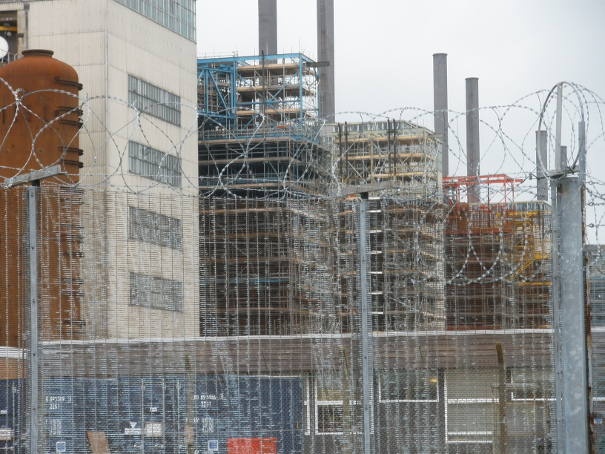A visit to Chapel Cross, the Magnox nuclear plant being decommissioned, near Annan in Dumfries and Galloway. It produced weapons-grade plutonium and electrical power for the UK national grid.
A scabrous, terrifying skeleton.
A friend suggested that the next time I’m in Dumfries and Galloway, I should go and see Chapel Cross near Annan. My research isn’t about nuclear power, or the leaks and incidents at plants or their decommissioning. I am curious, though, about the architecture of nuclear power stations, about what is visible above ground that houses and signifies this society’s relations with nuclear production.
Chapel Cross was a Magnox nuclear power plant, commissioned in 1959, to produce weapons-grade plutonium and latterly to produce electrical power for the UK national grid. Decommissioning began in 2004, with the final site clearance expected in 2085-2095.
Driving west on the A75, turning right down the narrow road towards Creca, the farmland is verdant. The site was built over an old airfield, and the land is seemingly flat, and today, green and bucolic. It could go on like this for miles.
A scabrous, terrifying skeleton rises up; it hits the eyes and looms over the road, reducing me to insignificance. The cooling towers have gone, structures that would have given a long-distance warning. I shake with fright. I was not expecting this, not so close to the road, not on this overcast, normal day. The building’s face has been burned off, and the exposed interior is broken, rotting, flapping in the wind. It reeks of decay and forebodes danger, as if some terrible thing has happened here and the land is still screaming.

I know, rationally, that these are buildings are subsidiary structures ‘made safe’; I’m not looking into an exposed reactor. There are dozens of cars in the car park; people are working here behind the fences. This is not so much a ruin as a controlled breaking down, but not like any other demolition.
The decomposition fills me with terror. We are not supposed to see this. The façade of nuclear normality is not supposed to fall. The surface is supposed to hold, and to keep us, the public, outside and reassured.
Once I have left, escaped the structure’s presence, I transpose this fright to another scale, in another place, below the surface of the sea, where the invisible and disparate Depleted Uranium shells are now circulating, decomposing.
For the rest of the research trip, I am compelled by the surface of the sea, needing it to be a barrier, and wondering whether that could break. I am unnerved.


